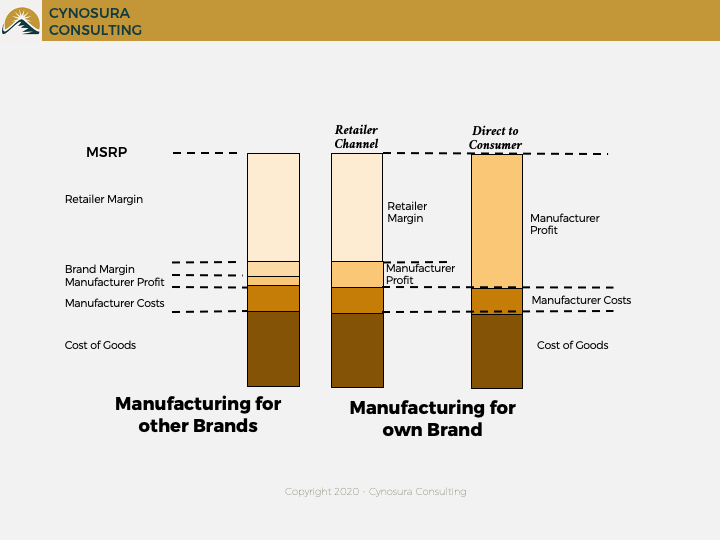Manufacturers Need Marketing to Become a Brand
© Convisum | Dreamstime.com
Manufacturers that want to create a brand need to be “Marketing-Centric”
“Marketing is as different from selling as chemistry is from alchemy, astronomy is from astrology, chess from checkers.”
Contract manufacturers that create their own brand can increase the potential for larger profit margins on products sold.
Most brands do not manufacture the products they sell in the marketplace. In most cases, the branded company does not own any manufacturing facilities and instead purchases their finished goods from a manufacturing supplier through what is typically called Contract Manufacturing. This reality is especially evident in consumer products such as electronics and apparel. For example, a separate company called Hon Hai Precision Industry Co., LTD (more commonly known as Foxconn), produces Apple's iPhone. Interestingly, this company also makes smartphones for Apple's competitors as well, which is not uncommon for many contract manufacturers. The fact is that many contract manufacturers are behind the scenes. In several cases, they are also responsible for the innovations that many brands tout as their own. I, too, worked for a contract manufacturer in the outdoor industry. Recognized as a leading innovator in hosiery manufacturing, we made products for many established brands as well as numerous private label retailers.
Today, contract manufacturers are starting to create consumer brands of their own. For example, Foxconn created a brand of smartphones. This idea is attractive, especially when you consider the potential profit margins. A manufacturer can realize a healthy gross margin on its own branded products compared to ones it manufactures for other brands. Many manufacturers, however, are not structured for creating a brand. The biggest challenge these companies face is a lack of a marketing-centric outlook due to adhering to a superannuated sales-centric mentality.
In my experience, profitable and growing contract manufacturers were successful by focusing on two critical tenets: 1) Quality Products and 2) Competitive Prices. This emphasis made sense. Their customers – Brands – were concerned about the same thing. The main difference is the role marketing plays in the relationship between manufacturer and brand compared to that of brand and consumer. It’s this difference that eludes manufacturers who wish to become a consumer brand. In their current customer relationship paradigm, a sales-centric strategy worked with marketing only seen as a support function to the sales organization.
David Kurtz’s four eras of marketing history from “Contemporary Marketing.”
This perspective has its roots in what author David Kurtz refers to as the “Sales Era.” In the book “Contemporary Marketing,” Kurtz discusses the four eras of marketing history. His evaluation identifies the “Sales Era” as a shift in the business/customer dynamics that occurred in the early 20th century as manufacturing output increased. Companies began to shift their focus on growing a sales force to find and retain customers. According to Kurtz, “Companies with a sales orientation assume that customers will resist purchasing nonessential goods and services and that the task of personal selling and advertising is to persuade them to buy. Kurtz further notes that “although marketing departments began to emerge, they tended to remain subordinate” to sales. The discussion of marketing history notes, however, that this era seemed to have faded in the middle of the last century – giving way to the Marketing Era and the Relationship Era. Yet today, many manufacturers still seem to remain in the Sales Era – perhaps because it works for them or maybe because they don’t know any different. Their reluctance to shift to marketing-centric orientation will hinder their ability to create and grow a brand. As Theodore Levitt said in “Marketing Myopia,” “The difference between marketing and selling is more than semantic. Selling focuses on the needs of the seller; marketing on the needs of the buyer.” Marketing emphasizes fulfilling consumer needs. Branding is one of the most powerful tools that can influence a customer’s product perceptions. Stated, you cannot become a brand without marketing. It is not a smooth transition from actively selling your products and manufacturing capability to the effort of marketing a brand to consumers. The same techniques used to achieve sales success previously will no longer work.
“Selling focuses on the needs of the seller; marketing on the needs of the buyer.”
So how does a manufacturer overcome its "Sales Era" paradigm to become a brand?
The most crucial step is to enter the 21st century and embrace the tenets of what Kurtz calls the "Relationship Era." This transformation involves developing long-term relationships with the entire value chain from suppliers to customers and other strategic partners. Coupled with this shift is recognizing the importance of marketing to building and sustaining these relationships. The marketing team can no longer be subordinate to sales. They need to be leading the brand's development efforts to include everything from branding to directing the marketing mix. Still, it's essential to recognize that the sales team's function doesn't change in this new orientation. Depending on the sales channels, a sales force will now need to promote and sell the branded product to retailers or distributors. Yet now, they are acting as part of the marketing mix – one of several effective promotion methods necessary to build brand awareness and growth. Although they are still selling a product, they are now also responsible for developing new relationships by promoting a brand.
Consider the contract manufacturer – Cabot Hosiery, located in Vermont. A multi-generational hosiery mill that began making socks in 1978 for apparel brands. But in the early 2000s, after many customers ended contracts with Cabot, the owners had to make a decision. They either had to close the mill or change their business model. The owner's son, Ric Cabot, proposed creating a brand. Instead of manufacturing for other companies, Cabot Hosiery became "Darn Tough." Instead of earning minimal profits from contracts, Darn Tough saw an opportunity to gain a significant gross margin by selling its socks at a premium price within a niche market. Their future success was rooted in their commitment to using marketing to develop and grow the brand, starting with the effective use of promotion to introduce the brand in 2004 when they gave away 3500 pairs of socks at the Vermont City Marathon. Word quickly spread about the sock's durability and the brand's game-changing value proposition of a "Lifetime Guarantee." By the 2010s, their distribution was nationwide, and the brand saw a 60% growth in annual sales. Today, they are a leading outdoor sock brand – second only to Smartwool according to most industry reports.
From Darn Tough Website
Companies that remain in the "Sales Era" are no longer relevant in today's "Relationship Era." They have to evolve. No longer can companies allow marketing to be subordinate to sales. A manufacturer that wants to create and grow a successful brand must be committed to establishing a marketing-centric organization. On the other hand, if a business chooses to retain its sales mentality, they may see short-term revenue, but they will fail to realize long-term brand growth.





